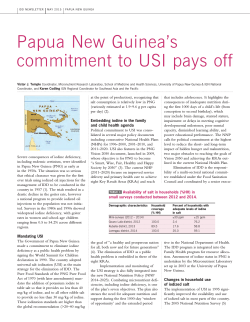
Sustaining USI achievements in Central and Eastern Europe
I D D N EWSL ET T ER M AY 2 0 1 5 C EN T RAL AN D EASTE RN E URO PE Sustaining USI achievements in Central and Eastern Europe Gregory Gerasimov IGN Regional Coordinator for Eastern Europe and Central Asia Harlan Harris; Flickr, CC BY NC 2.0 The workshops will primarily target opportunities but also new challenges as By 2000, only 26% of households across the national IDD/USI committees and will program priorities are shifting, and sustainaCEE/CIS region had access to adequately invite multi-sectoral participation of nutritibility efforts are becoming established. iodized salt. As political turmoil and milion program officials within the Ministries of UNICEF and GAIN, with support tary conflicts receded, USI strategies gained Health, IGN national representatives, senior from USAID, are organizing two conmomentum, and national coalitions were salt industry employees, as well as laboratory sultative workshops for the countries in activated country after country. By the end experts and civic activists from NGO/conthe Region: the first one for the Russianof 2009, 55% of the region’s population sumer protection organizations. This crossspeaking countries of the CIS, to be held had access to adequately iodized salt. At the societal participation is hoped to stimulate in Almaty (Kazakhstan) in July 2015, and same time, several countries had already discussion on a wide range of issues, enable the second for the Balkan/Southeastern officially achieved optimal iodine nutrition, the attendees to compare experiences, and European countries in October 2015. others were approaching this target and, share lessons learned from their colleagues These meetings will focus on experience importantly, the effective national ability to in order to determine the most pursue USI had been established in feasible and effective approaches to almost all CEE/CIS countries. These strengthening and sustaining national significant improvements resulted USI achievements. directly from a dramatic increase in The workshops will assist countries public–private partnerships and comin developing their 3–4 year “road mitment from key stakeholders. maps” to guide the development of Despite the impressive proan enabling environment and to progress, the context in which USI vide directions to sustained USI and programs are embedded continues to optimal iodine nutrition. Each road change. In more and more CEE/CIS map will provide a country-specific countries, processed foods are becoanalysis of bottlenecks and opporming an important source of dietary tunities for enhanced USI strategies iodine. In addition, the emphasis is that are in line with global guidelines gradually shifting towards reaching New forms of collaboration of salt reduction and salt iodization and practices. They will aim to identhe most vulnerable groups (pregnant strategies are needed to sustain IDD elimination across the Region tify the best approaches to address and lactating women, and infants) key barriers in lagging countries. The with iodine supplements and/or funcworkshops will also offer the first opportusharing and lessons learned from countries tional foods containing iodine, sometimes at nity to outline the steps for integrating natithe expense of promoting universal access to with successful USI programs, integraonal salt iodization and salt intake reduction ting the strategies of USI and salt intake iodized salt. In parallel, to combat the rising strategies. reduction, updating USI stakeholders on threat of hypertension and cardiovascular new developments in IDD prevention and disease, national strategies for reducing salt program management, as well as fostering intakes are gaining momentum. To avoid collaboration and coordination at the regicounter-productive policy practices, there is need to ensure synergy by promoting adjust- onal and national levels. In preparation for the workshops, the IGN and UNICEF will ments of iodization levels as salt intakes update the IDD/USI profiles for all coundecrease. This approach requires new forms tries in the Region and review the current of collaboration in policy development, trends to supplement the previous detailed research, monitoring and evaluation, and review with new data and add information advocacy and communication. The curon current salt intake reduction strategies. rent situation, therefore, presents not only 17
© Copyright 2025















